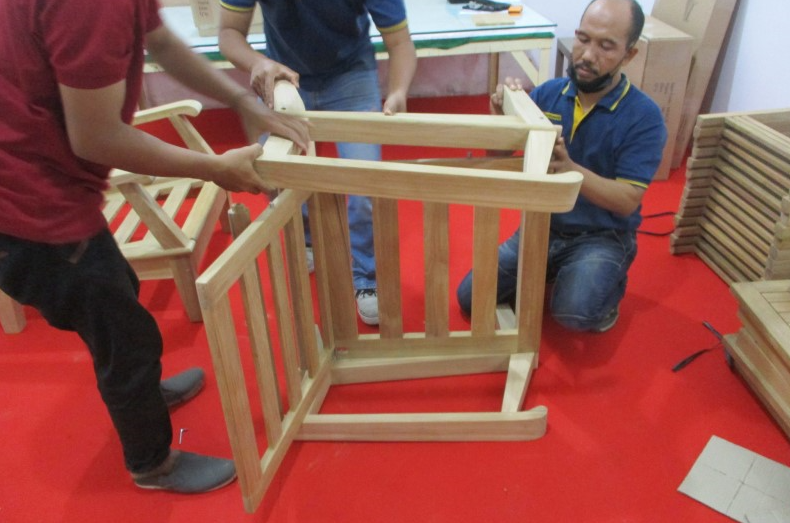
Chair Quality Control Inspections- Over my many years of coordinating and conducting Furniture quality control Inspections in many countries, I have received many calls from clients who need help with the quality of the chairs and other furniture products they are sourcing. I have decided to write this article to help folks understand how a chair is produced and the importance of having Chair Quality Control Inspections.
This article can also easily apply to other types of furniture. So, if you have any questions or queries, please get in touch with me. You will find my details at the end of this article.
The Critical Role of Chair Quality Control Inspections in Manufacturing
Quality control is paramount in chair manufacturing. As integral to our daily lives, chairs must meet stringent safety, aesthetics, longevity, and user satisfaction standards. Ensuring high-quality control in chair manufacturing is crucial for maintaining Poland’s reputation in the international furniture market. This meticulous approach involves scrutinizing every aspect of the chair, from material selection to the final finishing touches.
The Chair Production Process: A Quick Overview
Most chair production processes are a blend of traditional craftsmanship and modern technology. Knowing these stages assists our clients in determining their Chair Quality Control Inspection requirements. The process includes several critical steps:
- Timber Preparation: Wood selection and preparation are foundational in chair manufacturing. The Manufacturer should choose the highest quality timber for solid wood chairs, ensuring it is precisely cut, adequately dried, and meticulously machined. This stage is crucial for ensuring the wood’s longevity and aesthetic appeal. For chairs made from Steel or composite materials, the raw materials specifications must meet industry norms and any unique requirements from the destination market.
- Design and Prototyping: Every chair begins as a concept. Designs are carefully crafted, considering both aesthetics and ergonomics. Prototypes are then created to test these designs, ensuring that each chair is stylish but also comfortable and functional.
- Assembly: The assembly process can make or break a product. For flatpack furniture, continuous precision and attention to detail must be maintained during the chair’s production. It is paramount to produce a chair that is stable and durable. It ensures a chair’s longevity and user comfort.
- Upholstery (if applicable): Choosing suitable fabric and materials is paramount for chairs with upholstery. Buyers should check and reconfirm with the Manufacturer about the grade level and quality of the fabrics and materials used. A buyer should keep thinking about the durability and comfort of the chair while ensuring the upholstery complements the chair’s design.
- Varnishing and Finishing: The last production stage involves varnishing and applying finishing touches. It enhances the chair’s appearance, giving it a polished look and a protective layer to guard against wear and tear.
Common Defects and Quality Control Challenges in Chair Manufacturing
Despite the advanced modern production used, there can be many areas where there is a quality failure. These include:
- Defects in Wooden Materials: Wood, a natural material, can present various imperfections such as splits, warping, and knots. Chair manufacturers can address these issues by carefully selecting quality raw materials and correctly processing timber, e.g., correctly drying the wood.
- Upholstery Issues: For upholstered chairs, issues such as fabric tearing, misalignment, or inadequate padding can arise. These can be reduced by using high-quality materials and employing properly trained and skilled upholsterers.
- Assembly Errors: Misaligned components or loose fittings are potential issues in the assembly process. Furniture producers use precise techniques and quality control checks to assemble each chair correctly.
- Finish and Varnish Flaws: The chair’s final finish is essential for its looks and durability. Poor application of varnish or inadequate finishing will destroy the product’s value. Therefore, it is vital to have correct Chair Quality control processes and inspections in place to ensure a consistent and high-quality finish.
- Functional Defects: Chairs must be functional, balanced, and comfortable. Issues such as unbalanced legs or discomfort in seating can be prevented through good design, proper manufacturing, and quality checks.
Quality Control Inspection Techniques Used in Chair Manufacturing
Several types of inspections should be used to determine the quality of a chair. These inspections may occur during the various stages of chair production. These include:
- Completion Inspection: Ensuring all parts, user instructions, and hardware are present is essential for chairs requiring assembly.
- Assembly Inspection: The ease and accuracy of assembly are assessed, following the instructions.
- Visual Defect Inspection: Examining the chair’s overall appearance for aesthetic defects.
- Dimensional Inspection: Verifying that the chair meets all specified measurement requirements.
- Safety Inspection: Checking for potential safety hazards such as sharp edges or weak points.
- Functional Inspection: Assessing the chair’s stability and comfort, ensuring it functions as intended. Loading tests are also conducted during this phase.
- Drop Test Inspection: A crucial test for packing durability, particularly for flatpack chairs.
Chair Quality Control Inspections – Conclusion
A robust Chair Quality Control Inspection procedure ensures that every chair you source meets customer expectations. So, it is also considered best practice to have third-party quality control inspectors regularly visit the factory and conduct spot checks on the products. If interested, please visit Goodada’s Furniture Inspections page for more information.
Additionally, if you want to discuss how Goodada Inspections can help address your furniture quality issues, please get in touch with me below. Additionally, Goodada offers a full range of quality control services that help traders maintain vigilance on the suppliers and products.
So, for more information about Chair QC Inspections, contact:
Contact Person: Aidan Conaty
Mobile- Messenger (Click to Connect)
Laptop / PC (Click to Connect)
Phone:(Europe/ Rest of the World) +353 1 885 3919 ; (UK) +44.020.3287.2990 ; (North America) +1.518.290.6604


